Imagine opening Netflix to shows you’ll love or using Google Maps to skip traffic. These everyday conveniences rely on AI (Artificial Intelligence) and ML (Machine Learning), quietly making life easier, faster, and more connected.
By 2025, AI is expected to add $15.7 trillion to the global economy—more than the GDP of most countries. From diagnosing diseases to powering self-driving cars, AI and ML are transforming industries, enhancing gaming, creating generative media, and personalizing learning.
Why does this matter? Understanding AI isn’t just for tech experts. These systems shape how we shop, work, and see ads. Knowing how they work helps us use them wisely, protect our privacy, and make smarter choices. AI isn’t just a tool—it’s part of daily life.
History of AI and ML
The field of Artificial Intelligence (AI) has been a fascinating exploration of how machines can think and learn like humans. To truly appreciate where we are today, it helps to look back at how AI and its subset, Machine Learning (ML), began and evolved over time. Since its inception in the 1950s, AI has undergone cycles of optimism and disappointment, often referred to as AI winters, which have shaped its development and progress.
Early Seeds of AI
The idea of intelligent machines dates back to ancient myths, but AI became a scientific field in the mid-20th century with advances in computer science. In 1950, British mathematician Alan Turing introduced the Turing Test, asking if a machine could convince a human it’s also human in a text-based conversation. This became a cornerstone of AI and sparked debates about replicating intelligence.
AI officially began in 1956 at the Dartmouth Conference, organized by John McCarthy (who coined the term “Artificial Intelligence”) and others. It laid the foundation for studying how machines could mimic human reasoning and problem-solving.
Key Breakthroughs in AI and ML
In the following decades, researchers developed basic systems that could solve math problems, play games, or follow instructions. However, these systems couldn’t learn from experience.
The 1990s saw a turning point with advances in computing and data. In 1997, IBM’s Deep Blue defeated world chess champion Garry Kasparov, showcasing AI’s ability to handle complex tasks with strategy and computational power.
In 2016, Google DeepMind’s AlphaGo took another leap by mastering the board game Go using machine learning to analyze gameplay. Unlike Deep Blue, AlphaGo taught itself to improve, marking a major breakthrough.
More recently, OpenAI’s GPT models have shown AI’s ability to generate human-like text. Tools like ChatGPT can write, answer questions, and assist creatively, demonstrating progress in mimicking human communication.
The Rise of Machine Learning
In AI’s early days, it relied on hard-coded rules and logic. Machines were programmed to follow specific instructions, making them good at repetitive tasks but unable to adapt to new situations. This changed with Machine Learning.
By the late 20th century, researchers began teaching machines to “learn” from data instead of relying on pre-set rules. Machine learning allows systems to analyze data, improve over time, and make predictions. Algorithms like decision trees, support vector machines, and neural networks became common. For instance, instead of programming a computer to detect spam, developers could train a model with examples, enabling it to identify spam on its own.
Today, machine learning powers tools like Netflix recommendations and smartphone facial recognition. Its ability to quickly process large data and adapt has made it central to modern AI.
Where We Are Today
From Alan Turing’s ideas to milestones like Deep Blue, AlphaGo, and GPT models, AI and ML have become world-changing fields. Their history shows how far we’ve come and hints at future potential. For beginners, it’s a glimpse into the innovation driving today’s AI revolution.
What is Artificial Intelligence?
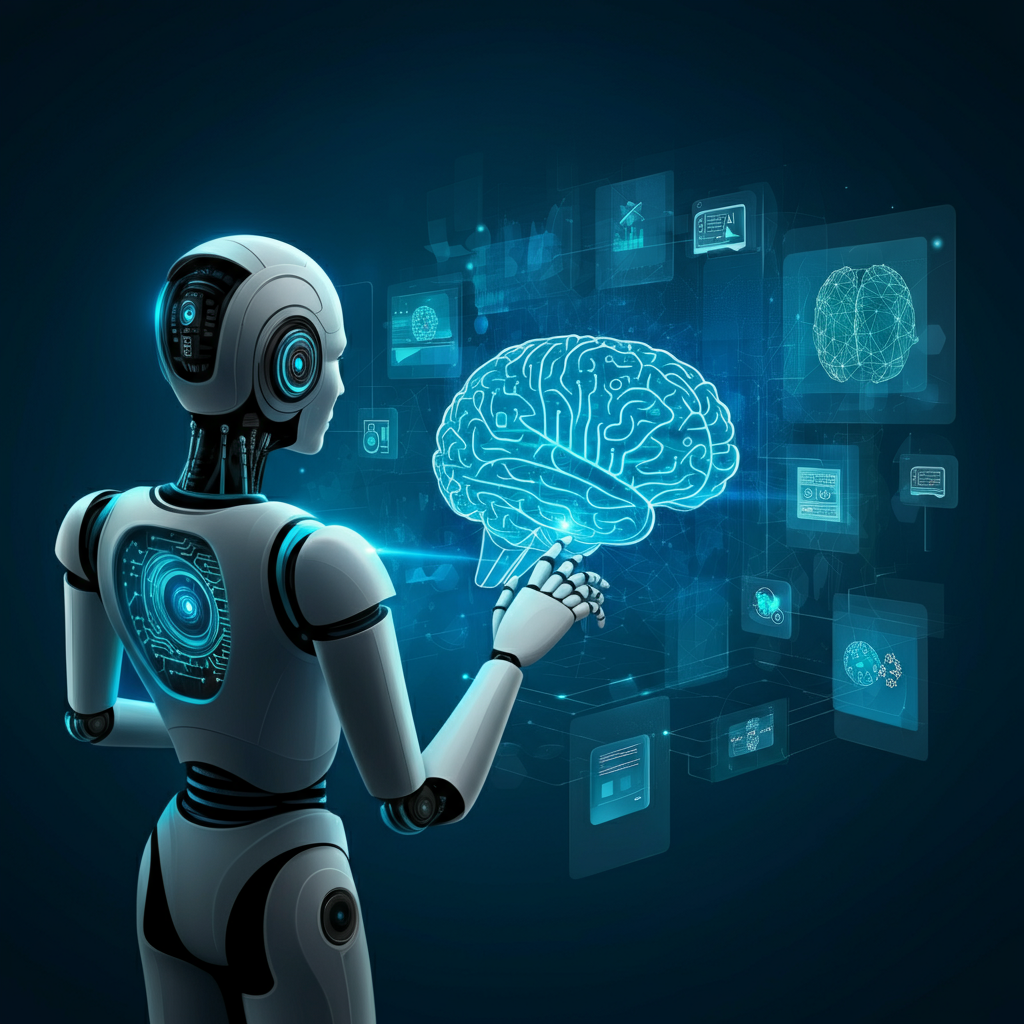
Artificial Intelligence (AI) refers to machines mimicking human intelligence to perform tasks like understanding language, recognizing images, making decisions, and learning from experience.
AI relies on algorithms—step-by-step instructions that guide computers in solving problems or completing tasks. Inspired by human cognition, AI uses data, algorithms, and computing power to process information, identify patterns, and make decisions.
Types of AI
Narrow AI
Also known as weak AI, this type is designed to perform a specific task. Examples include virtual assistants like Siri or Alexa, recommendation algorithms on Netflix, and face recognition in smartphones.General AI
Sometimes called strong AI, this would involve machines having the ability to perform any intellectual task that a human can do. General AI remains a theoretical concept for now.Super AI
A hypothetical scenario where AI surpasses human intelligence in all fields. While it exists mainly in science fiction today, it stirs active debates about its risks and potential benefits.
What is Machine Learning?
Machine Learning (ML) is a branch of AI that creates systems capable of learning and improving from experience without explicit programming for every scenario. Instead of solving specific problems with hand-coded rules, ML algorithms analyze data to find patterns and make decisions.
For example, email spam filters don’t rely on hard-coded rules for every spam type. They analyze large sets of emails and learn to spot common traits in spam messages.
How Machine Learning Works
Machine learning might sound complicated, but it’s about teaching computers to learn from examples. Instead of programming exact instructions, we give the computer data and a way to learn from it. Then, it figures things out on its own! This guide will break down the process in clear terms with easy examples.
Step 1: Collecting Data (The Fuel for Learning)

Imagine you’re trying to teach a friend to recognize birds. To do that, you’d show them lots of pictures of birds and explain, “This is a bird, and this is not a bird.” Machine learning works the same way. You need to gather lots of data so the computer has something to learn from.
What Kind of Data Do Machines Use?
Data can come in many forms depending on what we want the machine to do:
Pictures: If we’re teaching a machine to recognize cats, we gather images of cats (and maybe some without cats for comparison).
Text: To teach a machine to understand language, we collect books, articles, or conversation transcripts.
Numbers: For predicting things like stock prices, we might use spreadsheets or databases full of numerical data.
Sounds: If the goal is speech recognition, we’d collect recordings of people talking.
Historical Data: In AI applications for agriculture, historical data is used to enhance decision-making related to planting and crop yield optimization. Similarly, in disaster management, historical data helps analyze past evacuation patterns to improve future response strategies.
Why Is Good Data Important?
The quality of the data is just as important as the amount. If the pictures of cats are blurry or the stock price records are incomplete, the computer could end up learning the wrong things. The more varied and accurate the data, the smarter and more reliable the machine can become. For example:
If you’re teaching about cats, include pictures of cats in different colors and poses so the machine doesn’t think all cats are gray and sitting still.
If you’re working with text, include both formal and casual writing so the machine learns a wide range of language styles.
Good data is like giving the computer a complete picture of the world you’re teaching it about.
Step 2: Training the Model (Teaching the Machine to Learn)
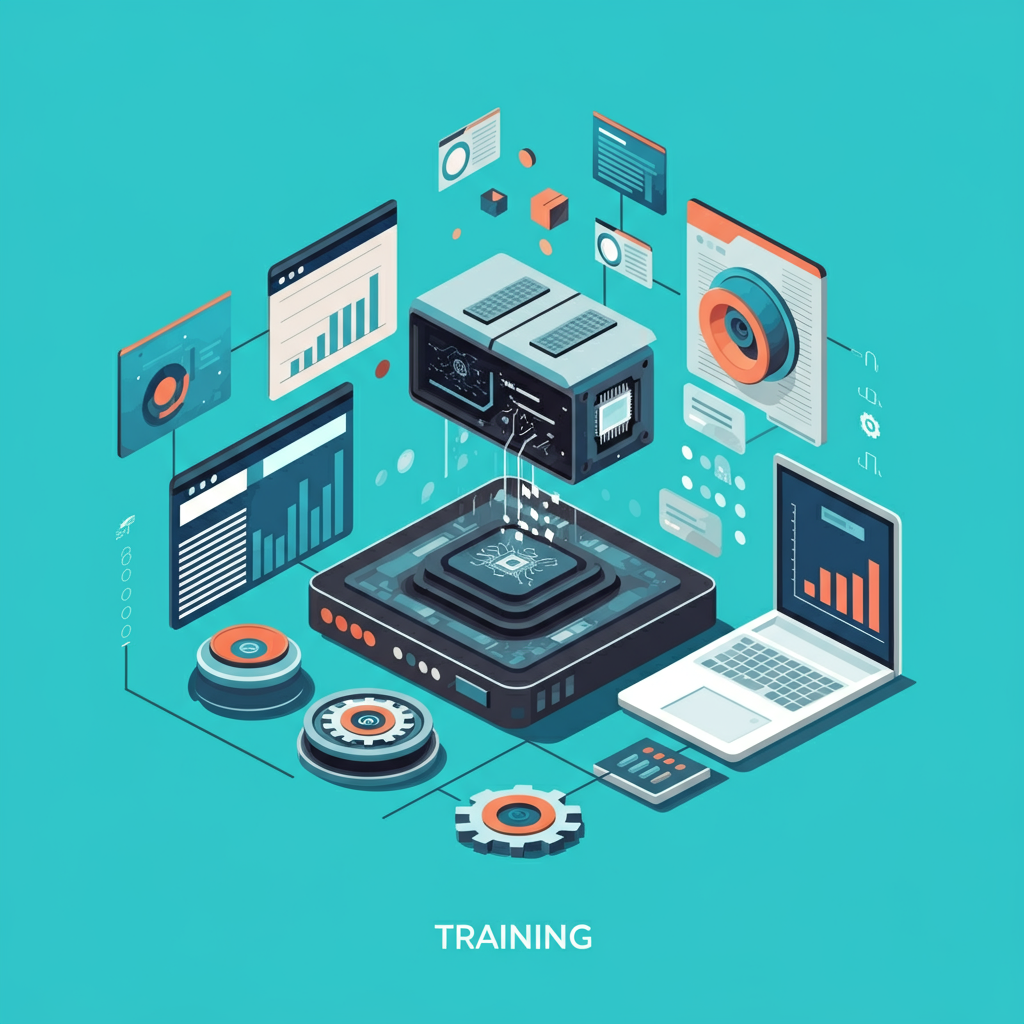
Once we have our data, it’s time to teach the machine. This step is called training the model.
How Does Training Work?
Think of the machine as a blank slate. It doesn’t know anything yet but uses tools (algorithms) to learn from examples. Here’s how training works:
The machine reviews the data we’ve collected, piece by piece.
It starts spotting patterns and drawing conclusions.
It adjusts based on feedback to improve.
For example, if we’re teaching it to recognize cats:
It might notice cats often have pointy ears and whiskers.
If it mistakes a dog for a cat, the algorithm corrects itself to avoid the same error.
This is similar to teaching a child with flashcards of animals, correcting mistakes until they learn to identify cats.
The Computer Gets Smarter Through Practice
The training process happens over and over, often thousands or even millions of times. Each round, the computer uses what it learned to improve its guesses. This repetition, combined with lots of data, helps the machine become really good at identifying patterns, making decisions, or solving problems.
Step 3: Evaluation and Adjustment (Checking How Well It’s Learning)
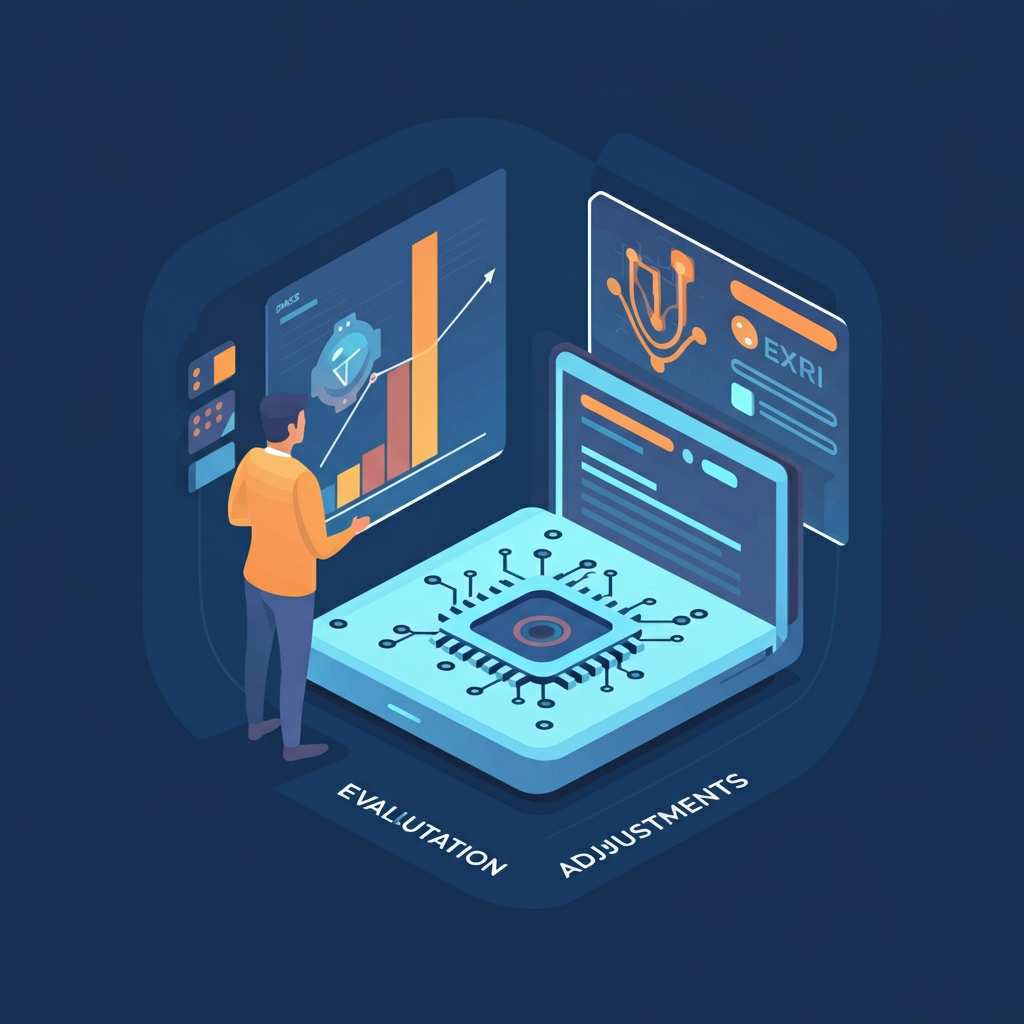
After the machine has been trained, we need to test it to see how well it has learned. This step is called evaluation.
Testing the Machine’s Skills
To test the machine, we show it data it has never seen before and see how well it does. For example:
If we trained it to recognize cats, we might give it a new picture of a cat and see if it gets the answer right.
If it was trained to understand text, we might ask it to summarize a sentence and check if the summary makes sense.
The goal is to find mistakes or areas where the machine can improve. For instance:
If the machine thinks a squirrel is a cat because it has pointy ears, we know it needs more training to recognize other differences, like body shape.
Tweaking and Improving the Model
If the machine isn’t performing well, we go back and adjust things. This could mean:
Feeding it more data so it can learn better.
Changing the algorithms it uses to process the data.
Refining how we train it to focus on what’s most important.
This process of testing and improving ensures that the machine is prepared to handle real-world tasks.
Step 4: Making Predictions (Using What It Learned)
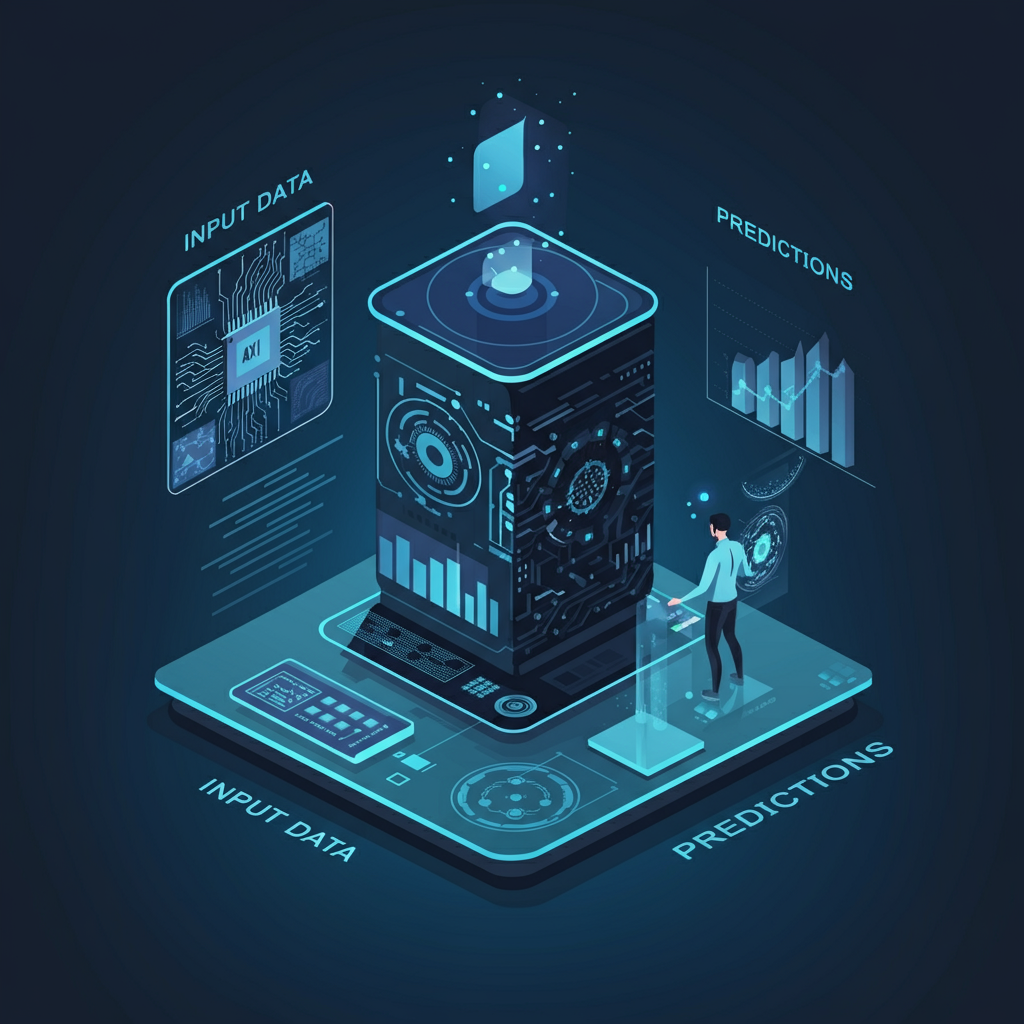
Once the machine has been trained and tested, it’s ready to use! It can now take new data and use what it learned to make predictions or decisions.
How Does Prediction Work?
When you give the machine new information, it compares it against the patterns it learned. Based on those patterns, it tries to make the best possible guess. For example:
If you show a picture, it might say, “This is a cat!” if it matches the patterns of a cat it learned during training.
If you type a phrase into a language translation app, it uses what it knows to convert your phrase into another language.
Real-World Examples
Here are some examples of how machine learning makes predictions in real life:
Spam Filters: Your email app uses machine learning to figure out which emails are spam and which are important.
Movie Recommendations: Streaming platforms like Netflix predict what movies you’ll like based on what you’ve already watched.
Self-Driving Cars: These cars use sensors and cameras to predict how other cars or pedestrians will move so they can drive safely.
Every time the machine makes a prediction, it’s applying what it learned during training.
Types of Machine Learning
Machine learning can take different approaches depending on how the system learns from the data provided. These approaches define the way a machine extracts insights and makes predictions. Here are the three primary types:
Supervised Learning
This method uses labeled data, where input data includes known answers or categories. For example, to train a model to classify images, you’d provide photos labeled “cat,” “dog,” etc. The algorithm learns to match patterns with these labels, allowing it to categorize new data. Applications include spam detection and handwriting recognition.
Unsupervised Learning
Unlike supervised learning, this technique works with unlabeled data. The algorithm identifies patterns, such as grouping similar items or spotting trends, without knowing what to look for in advance. Common methods include k-means and hierarchical clustering. For example, it can cluster customers by shopping habits to offer personalized recommendations. Unsupervised learning is great for uncovering unknown structures and hidden relationships in data.
Reinforcement Learning
This approach uses trial and error for decision-making. The model interacts with an environment, earning rewards for good actions and penalties for mistakes. Over time, it learns to maximize rewards. Reinforcement learning powers technologies like autonomous robots and game-playing AI, such as those mastering chess or Go.
Machine learning can do amazing things like recognizing faces, recommending music, translating languages, or diagnosing illnesses. While the process involves math and code, the idea is simple: with the right data and training, machines can learn patterns and make life easier!
AI vs. ML: What’s the Difference?
While AI and ML are interconnected, they are not the same. Understanding the distinction is key:
Scope
AI is a broader concept encompassing the idea of machines mimicking human intelligence. ML is a subset of AI that focuses on learning from data.Objective
AI aims to create intelligent systems capable of performing complex tasks. ML aims to improve accuracy and efficiency in performing specific tasks using data.Programming
AI involves logic, decision trees, and rules-based programming. ML relies on algorithms that can improve themselves through training.
How AI and ML Are Developed
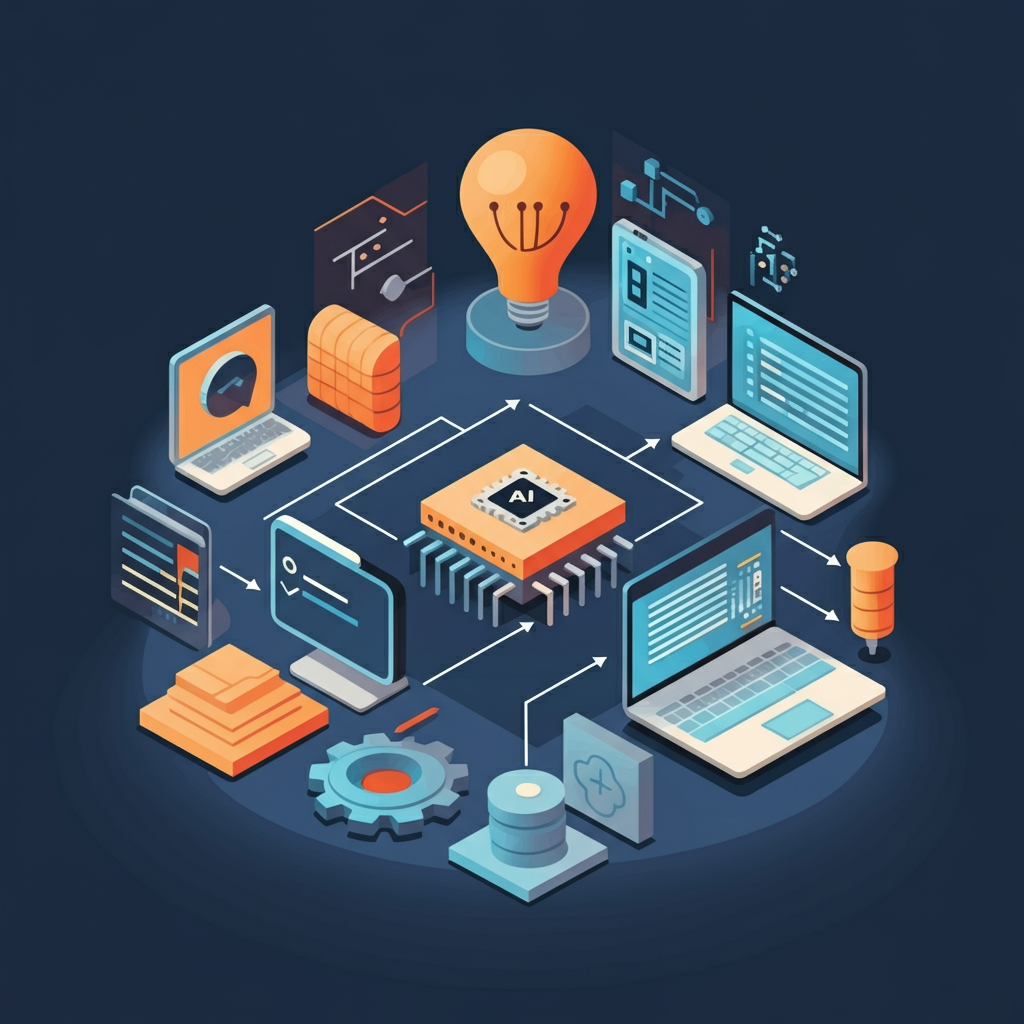
Creating AI and machine learning (ML) systems may sound complex, but at its core, it’s all about teaching computers to learn from data, using the right tools, and refining the process until the system works well. Here’s a simple breakdown of how it all comes together:
The Role of Data, Algorithms, and Computing Power
Data is the foundation of any AI/ML system. It’s like the fuel for learning. These systems rely on datasets (e.g., images, text, or numbers) to identify patterns and make predictions. For example, a model designed to recognize dogs in photos might need thousands of pictures of dogs, each labeled as “dog,” to train effectively. The more diverse and accurate the data, the better the system becomes.
Algorithms act as the engine. They’re the mathematical rules and procedures that help the system process the data. Different tasks require different types of algorithms. For example, a recommendation system like Netflix might use algorithms that predict what you’ll like based on your watching history.
Computing Power is the horsepower behind the process. Building and training these models requires large amounts of computing resources, particularly for complex tasks like image recognition or natural language processing. High-performance hardware, like GPUs (graphics processing units), is often used to speed up computations and handle large datasets efficiently.
Tools and Frameworks for AI/ML Development
Thankfully, developers don’t need to start from scratch when building AI/ML systems. There are popular tools and frameworks that make it easier to create and train models:
TensorFlow: Developed by Google, TensorFlow is one of the most widely used platforms for machine learning. It’s powerful for creating deep learning models and is flexible enough for both beginners and advanced users.
PyTorch: Loved by researchers and developers, PyTorch is an open-source library created by Facebook. It’s known for its simplicity and dynamic computational graph, which makes experimentation and tweaking easier.
Scikit-learn: A beginner-friendly library for tasks like classification, regression, and clustering. It’s great for smaller projects where deep learning isn’t required.
Keras (often built on top of TensorFlow): A user-friendly framework that simplifies the process of building advanced neural networks. It’s perfect for those who are just starting out.
These tools offer pre-built functions and models, so developers can focus on solving problems rather than coding everything from scratch.
The Iterative Process of Training, Testing, and Deployment
Building an AI/ML system isn’t a one-step process; it’s a cycle of improvement. Here’s how it usually works:
Training the Model
This is the initial phase where the AI system learns from the data. Developers feed the model the training data (e.g., images labeled as “cat” and “dog”) along with an algorithm to find patterns and make predictions. The goal is to help the model recognize and correctly classify new examples it hasn’t seen before.Testing the Model
Once trained, the system needs to be evaluated. Developers test the model using a separate dataset that wasn’t part of the training phase. This checks how well it performs with new, unseen data and highlights any weaknesses or errors.Tweaking and Refining
If the model doesn’t perform well, adjustments are made. This might involve feeding it more data, using a different algorithm, or fine-tuning hyperparameters (the settings that control the learning process). The model goes back into training and testing until its accuracy improves.Deploying the Model
Once the system performs reliably, it’s deployed into the real world. For example, the AI system behind a spam filter is put to work analyzing actual emails. Even after deployment, developers monitor the system and make updates as needed to keep it effective.
Making It All Work Together
Building AI and ML systems involves collecting data, choosing algorithms, using tools, and refining constantly. While resource-intensive, modern advancements make it easier for even beginners to create systems that learn and improve. From speech recognition to self-driving cars, it all starts with the same basics!
Challenges in AI and ML
AI and machine learning offer powerful capabilities but also face challenges. Understanding these limitations helps us appreciate their complexity and the need for ethical development. Here are three key challenges.
1. Data Quality Issues and Biases
AI and ML rely heavily on data to learn and make decisions. However, the quality of this data can significantly impact the performance and reliability of these systems.
The Problem with Poor Data:
Teaching someone to bake with a flawed recipe will likely lead to a failed cake. Similarly, if AI is trained on incomplete or poor-quality data, its predictions can be inaccurate. For example, a weather model with limited historical data may struggle to make reliable forecasts.Bias in Data:
Bias occurs when the data used to train an AI reflects systemic favoritism or prejudice. For example, a facial recognition system trained mostly on images of lighter-skinned individuals might struggle to recognize people with darker skin tones. This isn’t because the AI is inherently biased, but because it learns patterns only from the data it’s exposed to. Such biases can lead to unfair outcomes, like profiling or discrimination.The Solution:
Ensuring diverse and comprehensive datasets is key to reducing bias and improving data quality. Regularly auditing and updating training data can also help tackle these issues.
2. Computational and Resource Limitations
Building and running AI systems often require significant computing power and resources, which can make it challenging for smaller organizations or individuals to adopt the technology.
The Need for Powerful Hardware:
Training complex AI models, like those using deep learning, requires powerful hardware like GPUs or specialized chips. It’s like trying to fill a swimming pool with a garden hose—frustrating without enough computing power. This is why big tech companies with advanced technology often lead in AI development.High Energy Consumption:
The enormous energy required to train AI models contributes to their environmental impact. For example, training a single large language model can emit carbon dioxide equivalent to the lifetime emissions of five cars. This makes it crucial to balance progress with sustainability.The Solution:
Researchers are working on optimizing algorithms to make AI more efficient while exploring alternative energy sources. Cloud computing services also make it easier for smaller players to access high-level resources without owning expensive hardware.
3. Ethical Dilemmas and the “Black Box” Problem
AI systems don’t just come with technical challenges; they also raise ethical questions about their use and development.
The “Black Box” Problem:
Many machine learning models, especially neural networks, work like black boxes. They make decisions, but developers often can’t explain how. For example, if an AI denies a loan, the customer may not understand why due to the system’s lack of transparency. This can lead to mistrust.Ethical Concerns:
AI systems can be misused or cause unintentional harm. For example, deepfake technology has been used to create fake videos without consent, and automated hiring systems may reject qualified candidates due to biased training data. These issues raise concerns about accountability and responsibility.The Solution:
Researchers and developers are increasingly focusing on creating explainable AI (XAI), which aims to make decision-making processes more transparent. There’s also a growing push for governments and organizations to establish ethical guidelines and regulations to govern AI use responsibly.
Why It’s Important to Address These Challenges
No technology is perfect, and AI and ML are no exceptions. Recognizing their challenges allows us to address them. Whether it’s improving data, finding greener ways to power development, or tackling ethical concerns, each issue is a chance to create better, fairer, and more trustworthy AI systems.
AI and ML are powerful tools, but their impact relies on using them responsibly. Understanding their limits and potential helps us harness their benefits thoughtfully and ethically.
Future Trends in AI and ML
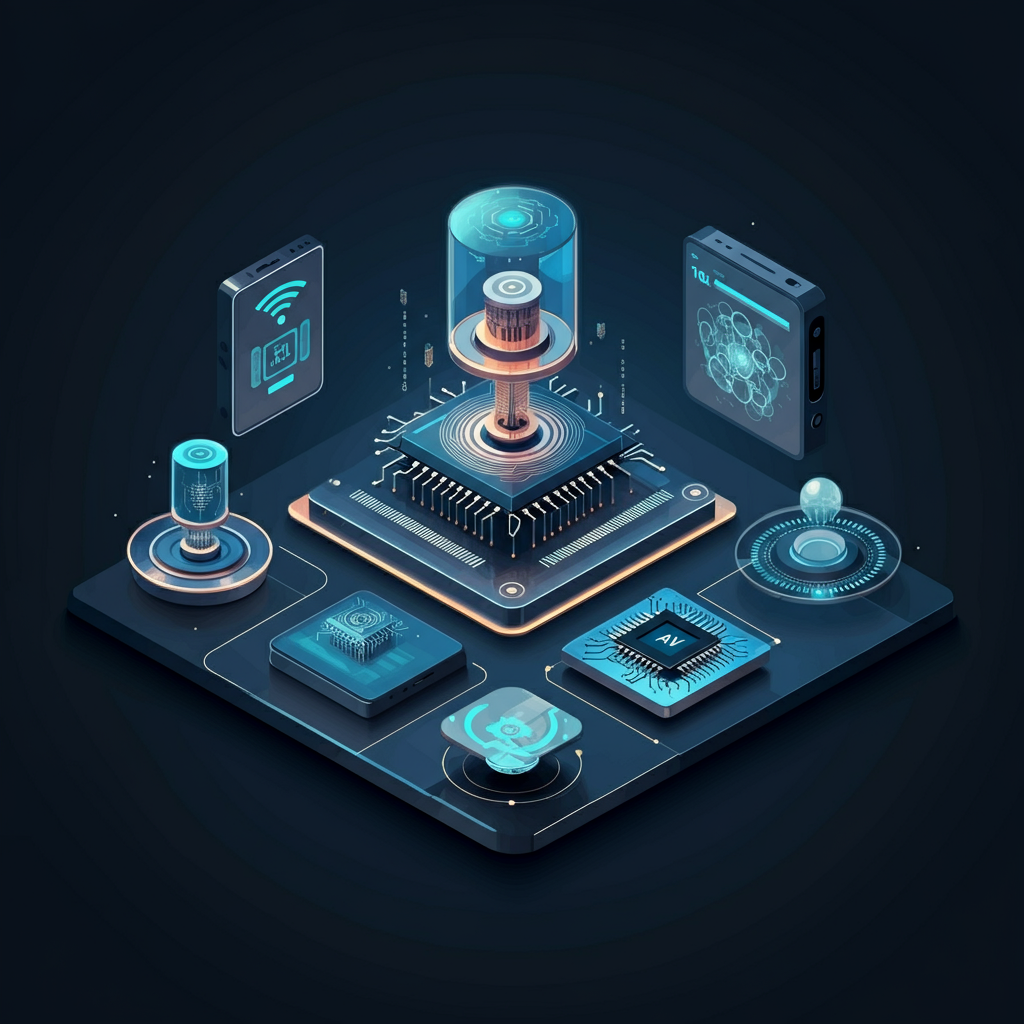
The world of AI and machine learning (ML) is evolving rapidly, bringing us closer to advancements that once seemed purely science fiction. These technologies are laying the groundwork for innovation across industries, and understanding their future possibilities can be both exciting and inspiring. Here, we’ll explore a few key trends shaping the next generation of AI and ML.
1. Generative AI (Like ChatGPT and DALL-E)
Generative AI refers to systems that can create entirely new content, from text and images to music and videos. These systems use advanced ML models, typically in the form of neural networks, to produce outputs that feel almost human-made. Generative AI technologies include chatbots like ChatGPT and text-to-image systems such as DALL-E and Midjourney.
Text Generation:
Tools like ChatGPT are reshaping how we interact with technology by generating human-like text. They’re already being used for tasks like writing emails, drafting stories, and even creating code snippets. Imagine having a personal assistant that not only understands you but can also help you write an effective speech or brainstorm creative ideas on demand.Image and Video Creation:
AI models like DALL-E can create stunning, lifelike images based on simple text descriptions (e.g., “A futuristic cityscape at sunset with flying cars”). These tools are revolutionizing industries such as graphic design, marketing, and entertainment. Generative AI also extends to video creation, where tools can develop animations and realistic video effects in minutes rather than months.Real-World Potential:
Generative AI could revolutionize creativity, education, and even mental healthcare by providing tools to visualize and express ideas. However, as exciting as this is, it also raises concerns about misuse, such as the creation of deepfakes or misleading media, making its ethical development critical.
2. AI in Quantum Computing and IoT
AI and ML are intersecting with other groundbreaking technologies, propelling them to new heights.
Quantum Computing:
Quantum computers, unlike traditional computers, can process massive amounts of data simultaneously, using the principles of quantum mechanics. When paired with AI, they could solve problems that are currently impossible. For example, quantum-enhanced AI might accelerate drug discovery by simulating complex molecular interactions in hours instead of years. This could lead to groundbreaking treatments for diseases.Internet of Things (IoT):
The IoT ecosystem connects billions of devices—from smart speakers to industrial machines. AI is playing a central role here by analyzing data from these devices to optimize operations and improve decision-making. For instance, in smart homes, sensors powered by AI can adjust lights, temperature, and security systems based on your preferences. Similarly, in industries, AI-driven IoT systems can predict equipment failures before they happen, saving costs and preventing downtime.What This Means for the Future:
The combined power of quantum computing and AI can unlock possibilities we haven’t yet dreamed of, solving global challenges like climate change modeling or addressing complex supply chain problems. IoT’s partnership with AI is likely to shape smarter cities and more intelligent automation systems.
3. Predictions for AI in Key Industries
The impact of AI and ML will continue to expand across industries, shaping every aspect of our lives. Here are a few areas where we’re likely to see revolutionary changes:
Healthcare:
AI is expected to transform healthcare through personalized medicine and predictive diagnostics. For example, AI could analyze your genetic data to predict diseases you’re more likely to develop and help create tailored treatment plans. Robots powered by AI might assist with surgeries, improving precision. Furthermore, wearable healthcare devices will play a critical role in making real-time health monitoring and early detection more accessible.Education:
Imagine classrooms where AI assistants provide personalized tutoring for every student. These systems could adapt learning materials based on a student’s strengths and weaknesses, ensuring they understand concepts at their own pace. Language learning apps will become even more conversational, making it easier to learn new languages fluently.Space Exploration:
AI is already helping analyze vast datasets from space telescopes, but its potential in astronomy is much greater. AI could support autonomous space missions, enabling spacecraft to react to unexpected conditions without waiting for instructions from Earth. For example, AI-driven rovers on Mars could independently decide which rocks are worth sampling or predict dust storms to move into safer locations. The role of AI in identifying habitable planets or spotting anomalies in astronomical data could open new doors to exploring the cosmos.
Why These Trends Matter
The future of AI and ML offers opportunities to improve lives, solve problems, and spark creativity. Generative AI unlocks endless possibilities, while quantum computing and IoT will boost efficiency on a large scale. In industries like healthcare, education, and space exploration, AI is driving progress.
But with growth come challenges. Ethical concerns and data security risks make responsible AI development crucial to ensure it benefits everyone.
The future of AI and ML is exciting and full of potential—this is just the beginning of their transformative impact.
AI and ML in Everyday Life
Artificial Intelligence and Machine Learning have quietly integrated into our daily routines, often in ways we don’t even realize. From the devices we use to the services we rely on, these technologies are working behind the scenes to make our lives more convenient, personalized, and efficient. Here’s how:
Virtual Assistants

Think about the times you’ve asked Siri to set a reminder, told Alexa to turn on the lights, or asked Google Assistant for directions. These virtual assistants are powered by AI and ML to understand and respond to your commands.
Here’s how they work:
Speech Recognition: When you say, “What’s the weather like today?” the assistant converts your voice into text and analyzes the words to understand your request.
Natural Language Processing (NLP): Using NLP, the assistant interprets the meaning of your sentence and identifies the action needed, such as fetching the weather forecast.
Personalization: Over time, these systems learn from your interactions. For instance, they might remember your preferred temperature units or frequently requested locations.
These assistants streamline small but essential tasks, making technology feel more intuitive.
Personalized Ads and Social Media Algorithms
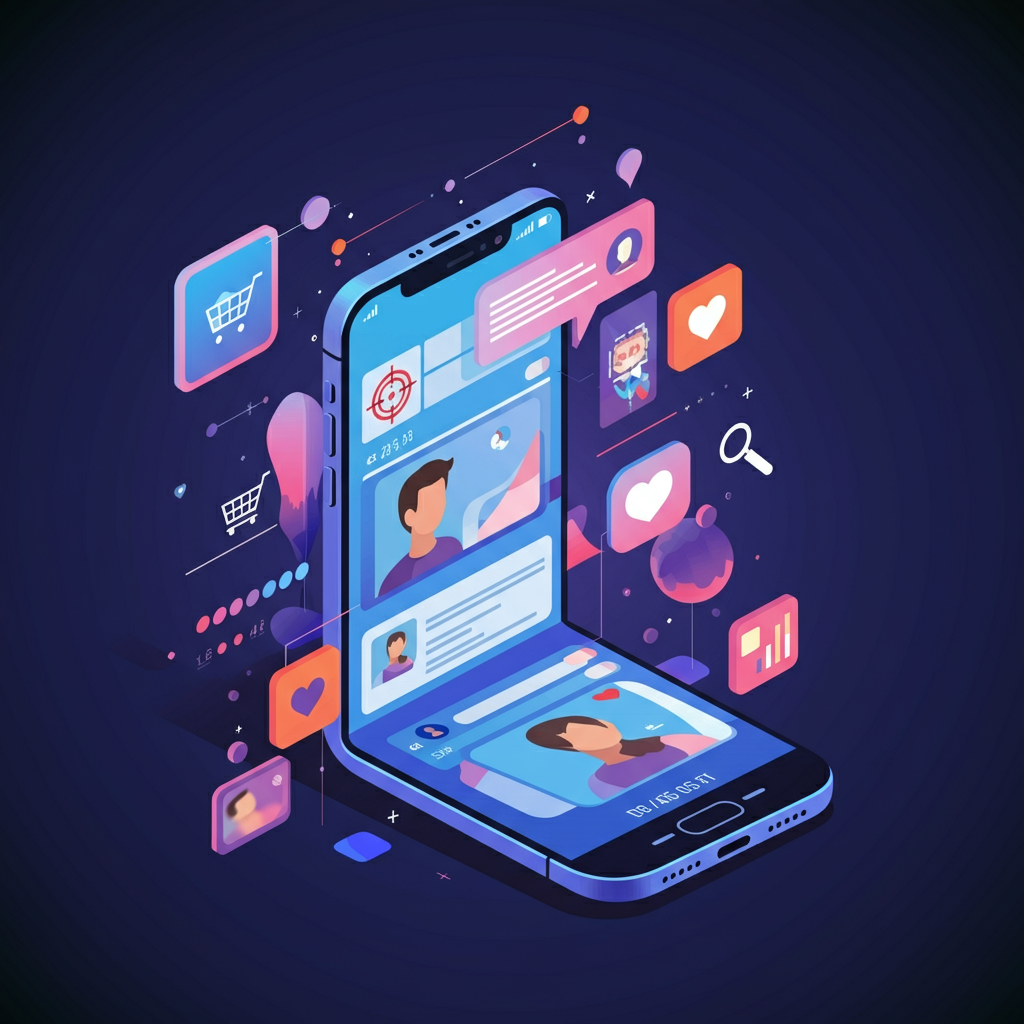
Ever wondered how Instagram seems to know you love cooking videos or why an ad for running shoes pops up after you search for fitness tips? That’s AI and ML at work.
Social media platforms and online advertisers use machine learning algorithms to analyze data about your behavior, like:
The posts you like, share, or spend time viewing.
The products you search for on e-commerce sites.
Your demographic information, such as age, location, and interests.
By identifying patterns, these systems create a personalized feed or ad experience tailored to your preferences. While some might find this helpful, it does raise concerns about data privacy, making it an ongoing topic of discussion in the tech world.
AI in Smart Home Devices

Smart home gadgets, from thermostats to security cameras, are great examples of how AI has made our homes more efficient. Devices like Nest Thermostats and Ring Doorbells use ML to adapt and serve your needs better:
Thermostats learn your habits, such as when you like your home warmer or cooler, and automatically adjust settings to save energy.
Security Cameras use computer vision, a type of AI, to recognize faces or detect unusual activities, sending you alerts for potential security concerns.
Even robotic vacuum cleaners like Roomba use AI to map your home, learning where obstacles like furniture are located to clean more effectively.
Fitness Apps and Wearables

If you’re tracking steps, monitoring your heart rate, or following a custom workout plan, chances are AI and ML are helping you stay on top of your health goals. Devices like Fitbit or apps like MyFitnessPal analyze your activity and habits to offer:
Insights on your performance, such as trends in daily steps or sleep quality.
Suggestions for improvement, like setting realistic goals based on past data.
Alerts about irregularities, such as an unusual increase in heart rate.
By constantly learning from your data, these technologies make health tracking more intuitive and actionable.
The Impact on Daily Life
AI and ML might not be visible, but their impact is clear. They save time, reduce effort, and make technology feel more human. From personalized recommendations to devices that adapt to your needs, these technologies improve convenience in ways we rely on. While they make life easier, it’s important to stay aware of how our data is used and balance convenience with privacy.
Key Concepts and Terminology to Know
To better understand AI and ML, it helps to get familiar with some common terms:
Algorithm – A set of rules or instructions computers follow to solve problems.
Neural Network – A type of ML inspired by the human brain, consisting of layers of interconnected nodes called neurons.
Deep Learning – A subfield of ML focused on neural networks with many layers. Applications include voice assistants, self-driving cars, and facial recognition.
Big Data – Large sets of data used for training AI algorithms. The more data you have, the better the AI performs.
Computer Vision – A field of AI focused on enabling machines to interpret and process visual data like images and videos.
Natural Language Processing (NLP) – A field within AI that focuses on the interaction between computers and human language, enabling tasks like translation and text analysis.
Real-World Applications of AI and Machine Learning
AI and ML are everywhere in our daily lives, often in ways we don’t even realize. Here are some examples:
Healthcare
AI-powered tools assist in diagnosing diseases, predicting patient outcomes, and personalizing treatment plans. For instance, AI can analyze medical images to detect early signs of conditions like cancer.Transportation
Self-driving cars, enabled by AI, use computer vision and machine learning to understand their surroundings and make driving decisions.Retail and E-commerce
ML algorithms are behind personalized product recommendations, dynamic pricing strategies, and chatbots that enhance customer support.Finance
AI helps detect fraudulent transactions, predict stock market trends, and automate financial services like lending.Entertainment
Streaming platforms like Netflix use machine learning to recommend shows and movies based on user preferences.Education
AI-driven tools like personalized tutors or automated grading systems are making learning more accessible and engaging.Marketing
Advertisers leverage AI for better targeting and customer segmentation. AI-powered tools like chatbots also enhance user experiences.Social Media
From content curation to facial recognition in photos, AI powers many features on platforms like Facebook, Instagram, and TikTok.
Ethical Concerns in AI and Machine Learning
AI and Machine Learning (ML) are powerful tools that help make life easier, but they also come with their own set of challenges. Here are some important issues to think about when it comes to using these technologies.
1. Bias in AI Systems
AI learns from data, and if that data is biased or incomplete, it can make mistakes. For instance, some facial recognition systems struggle to identify people with darker skin due to a lack of diverse training data. This can lead to unfair outcomes, like misidentifications or exclusions.
While AI is full of potential, it also carries risks. Like any powerful tool, if not used carefully, it can cause harm or unexpected issues. Here are some key risks to consider:
AI systems learn from data, but if the data is biased, the AI will be too. For example:
Hiring Bias: Some companies use AI to sort through job applications. If the system is trained on biased data, it might favor one group of people over others, even if everyone is equally qualified.
Facial Recognition Issues: Some facial recognition systems have trouble identifying certain ethnicities or genders accurately because of a lack of diversity in the training data. This can lead to unfair treatment or even legal complications.
How to Fix It:
Make sure AI is trained with data that includes all types of people and situations.
Test AI systems often to catch and fix unfairness.
Have teams with diverse backgrounds work on developing AI to spot problems early.
2. Protecting Privacy

AI often relies on collecting and analyzing personal data. While this data can be used to improve experiences, like showing you relevant content or helping solve crimes, it can also be misused or make people uncomfortable when there’s no clear explanation of how it’s being handled., it can also feel invasive. For example:
Social media platforms may track your likes, shares, and searches to serve you targeted ads.
Surveillance systems like street cameras can use AI to monitor people’s movements without their consent.
If this data falls into the wrong hands or is used irresponsibly, it can harm individual freedoms and threaten privacy.
How to Fix It:
Create stronger rules that give people control over their data and explain how it’s being used.
Use smarter methods that allow AI to learn without directly accessing personal information.
Be honest and open about how data is collected and why.
3. Jobs Being Taken Over by Machines
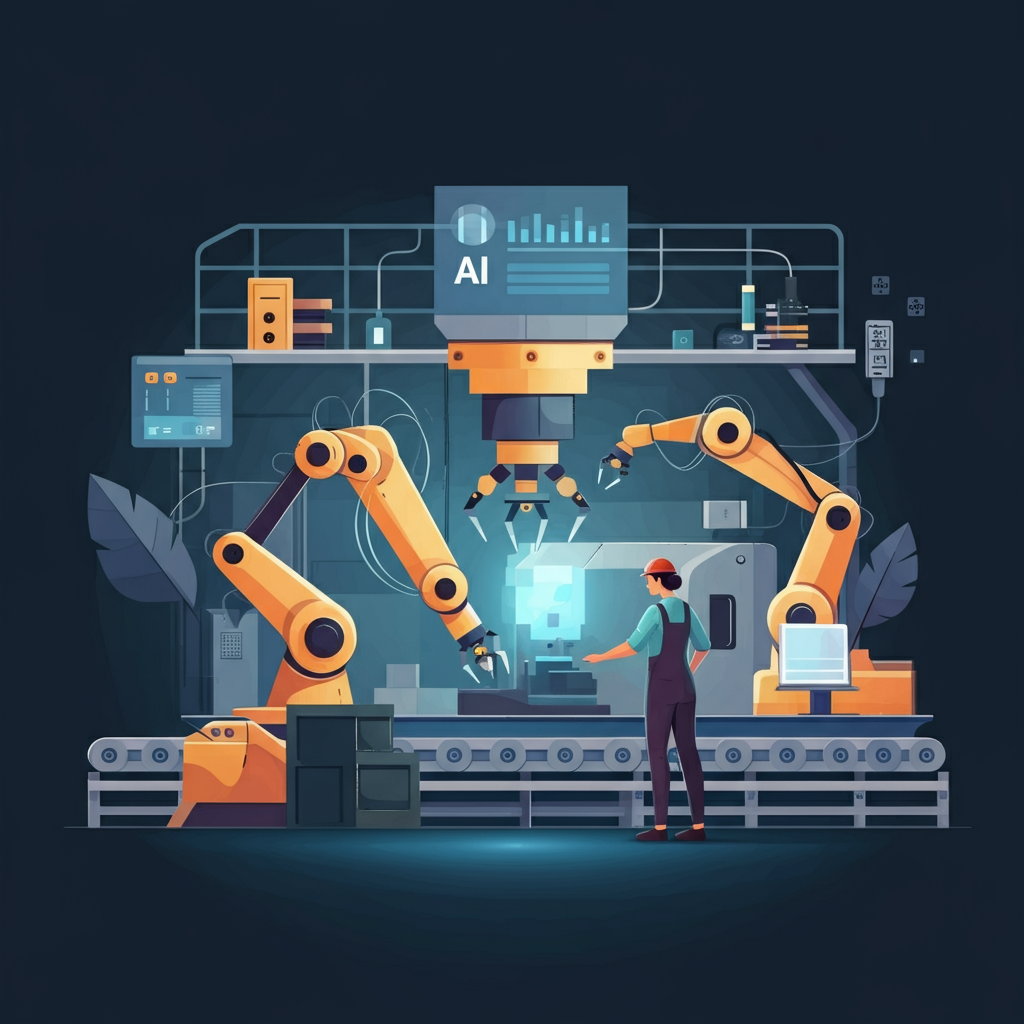
AI and ML excel at completing tasks quickly and efficiently, but they also replace jobs once done by humans. For example, self-checkout kiosks and assembly-line robots take over repetitive tasks. While this speeds up businesses, it can leave workers, especially in low-skill jobs, unemployed.
How to Fix It:
Offer training programs to help people learn new skills for jobs that need human expertise, like managing AI systems or creative problem-solving.
Have companies and governments work together to create new job opportunities and support workers during transitions.
Find ways for humans and AI to work together instead of replacing one with the other.
4. Making AI Safe and Fair
AI is powerful, but it must benefit everyone and avoid causing harm. Without clear rules, it could be used unfairly or without accountability. For instance, who’s responsible if an AI car crashes? Or how do we handle AI spreading misinformation?
Companies, governments, and communities must work together to create laws and guidelines for responsible AI use.
How to Fix It:
Introduce global rules and principles to make AI safe and fair to everyone.
Test AI thoroughly before using it in real-world situations.
Include input from different groups of people, not just tech companies, when setting rules.
5.Over-Reliance on AI
AI systems are smart, but they’re not perfect. Over-relying on them can lead to poor decision-making. For example:
Self-driving cars are impressive, but they may struggle in unusual traffic situations. Depending on them entirely could lead to accidents.
AI in healthcare can make faster diagnoses, but if it misses a rare disease, a human doctor might not double-check the result.
Relying too heavily on AI without human judgment can lead to unintended consequences.
Why AI and ML Matter
AI and Machine Learning (ML) are changing the world in ways that touch nearly every part of our lives. These technologies make our daily routines easier, solve some of the biggest challenges we face, and even improve industries we depend on. But as exciting as this is, it’s important to use AI and ML in ways that are fair and thoughtful.
Transforming Everyday Life and Industries
AI and ML are part of our daily lives, often without us noticing. Wonder how Netflix suggests shows or how your phone unlocks with your face? That’s AI! These systems also make industries like healthcare, finance, and transportation more efficient.
For instance:
Healthcare: Doctors use AI to find diseases earlier, like cancer in medical images, helping patients get treatment faster.
Retail: Shopping sites suggest products based on what you like, making online shopping more personal.
Transportation: Self-driving cars and traffic prediction tools are making travel safer and more efficient.
The ability of AI and ML to spot patterns and solve problems is helping companies and individuals save time, money, and effort.
Tackling Big Global Problems
AI and ML aren’t just about making life more convenient. They’re also taking on some of the biggest challenges in the world:
Climate Change: AI predicts weather patterns, helping scientists understand and respond to extreme weather. It’s even being used to improve renewable energy systems like wind and solar power.
Disaster Prediction: ML analyzes earthquake or hurricane data to warn people faster, potentially saving lives.
Healthcare Access: Tools powered by AI are bringing medical services to remote areas, diagnosing diseases through photos even where no doctors are available.
These technologies give us new tools to work on challenges that once felt overwhelming, offering hope for a better, safer future.
Why Responsible Use is Important
While AI and ML bring incredible opportunities, they can also cause harm if used carelessly. For example, poorly designed systems can make unfair decisions, invade privacy, or take over jobs without plans to support affected workers. That’s why using AI responsibly is just as important as its design.
How can we make sure AI’s impact stays positive?
Develop systems that are fair and inclusive, considering all kinds of people and needs.
Protect data, ensuring people have control over their private information.
Encourage governments, companies, and communities to work together on clear rules for how AI is developed and used.
A Smarter, Brighter Future
AI and ML hold the keys to solving problems big and small, from helping you find the perfect movie to fighting climate change. But the true power of these technologies lies in how we use them. By adopting them responsibly and ethically, we can create a future that’s smarter, fairer, and better for everyone.
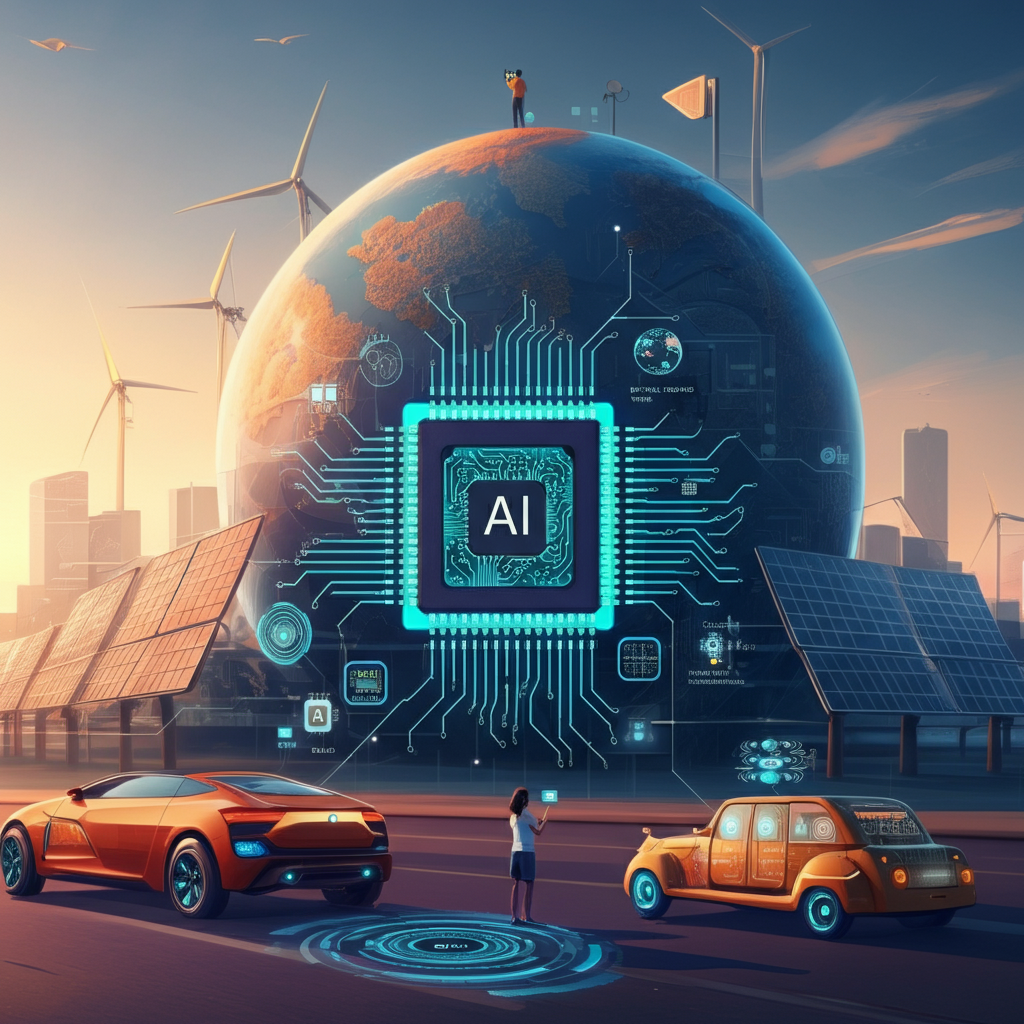
Definition of Artificial Intelligence
Artificial intelligence (AI) refers to computer systems designed to perform tasks that typically require human intelligence, such as learning, problem-solving, decision-making, and perception. Using algorithms and data, AI can make predictions, classify objects, and generate insights with impressive speed and accuracy.
Imagine a computer diagnosing diseases as accurately as a doctor or a virtual assistant understanding and responding to questions like a human. These are examples of AI in action. AI mimics human cognitive functions, learning from experience and adapting to new situations.
Over the years, AI applications have grown across industries. In healthcare, AI analyzes medical images and predicts patient outcomes. In finance, it detects fraud and automates trading. In transportation, AI powers self-driving cars and optimizes traffic. In education, it personalizes learning and streamlines administrative tasks.
AI is not a distant concept—it’s a transformative tool reshaping how we live and work. Understanding its basics helps us appreciate its potential and make informed choices about its role in our lives.
Deep Learning and Neural Networks
Deep learning is a subset of machine learning that involves the use of neural networks to analyze and interpret data. Think of neural networks as a series of interconnected layers, each composed of nodes or “neurons” that process and transmit information. These networks are inspired by the human brain, where neurons work together to understand and respond to complex stimuli.
In deep learning, algorithms use these neural networks to learn complex patterns and relationships in data. For example, when you upload a photo to a social media platform, deep learning algorithms can identify faces, objects, and even emotions in the image. This is possible because the neural networks have been trained on vast amounts of data, allowing them to recognize intricate details and make accurate predictions.
One of the most exciting applications of deep learning is in natural language processing (NLP). NLP enables computers to understand and generate human language, making it possible for virtual assistants like Siri and Alexa to respond to your voice commands. Deep learning algorithms analyze the structure and meaning of sentences, allowing these systems to provide relevant and accurate answers.
Deep learning is also used in predictive analytics, where it helps businesses forecast trends and make data-driven decisions. For instance, retailers use deep learning to predict customer preferences and recommend products, while financial institutions use it to assess credit risk and detect fraud.
In summary, deep learning and neural networks are powerful tools that enable machines to learn from data and perform tasks that were once thought to be the exclusive domain of humans. By leveraging these technologies, we can unlock new possibilities and drive innovation across various fields.
Natural Language Processing
Natural language processing (NLP) is a field of artificial intelligence that focuses on the interaction between computers and humans using natural language. In other words, NLP enables machines to understand, interpret, and respond to human language in a way that feels natural and intuitive.
Imagine being able to speak to your computer or smartphone and have it understand and respond to your questions. This is made possible by NLP, which uses algorithms and statistical models to process and analyze human language. For example, when you ask your virtual assistant for the weather forecast, NLP algorithms analyze your speech, convert it into text, and interpret the meaning to provide an accurate response.
NLP has a wide range of applications that make our lives easier and more efficient. Language translation tools, like Google Translate, use NLP to convert text from one language to another, breaking down language barriers and enabling global communication. Sentiment analysis tools analyze social media posts and customer reviews to determine public opinion and sentiment, helping businesses understand their customers better.
Text summarization is another important application of NLP. It involves condensing long documents or articles into shorter summaries while retaining the key information. This is particularly useful for news aggregation services and academic research, where users need to quickly grasp the main points of lengthy texts.
NLP also plays a crucial role in chatbots and customer service automation. By understanding and responding to customer queries, NLP-powered chatbots provide instant support and improve customer satisfaction. These systems can handle a wide range of tasks, from answering frequently asked questions to processing orders and reservations.
In conclusion, natural language processing is a vital component of artificial intelligence that enables machines to understand and interact with human language. Its applications are vast and varied, making it an essential technology for enhancing communication, improving customer experiences, and driving innovation in numerous fields.
AI Terminology Explained
Large Language Models (LLMs)
Large Language Models (LLMs) are a fascinating aspect of artificial intelligence (AI) designed to process and generate human language. Imagine having a conversation with a chatbot that understands and responds just like a human. This is made possible by LLMs, which are trained on vast amounts of text data. By learning patterns and relationships within language, these models can perform tasks such as language translation, text summarization, and even creative writing.
For instance, tools like OpenAI’s GPT-3 can generate human-like text, making them invaluable for applications like chatbots, virtual assistants, and content creation. These AI systems can understand context, generate coherent responses, and even mimic different writing styles, showcasing the incredible potential of LLMs in generating human language.
Datasets
In the world of artificial intelligence (AI), datasets are the backbone of model training and testing. Think of datasets as the raw material that AI models need to learn and improve. These collections of data can include images, text, audio, and more, paired with corresponding labels or classifications.
For example, to train an AI model to recognize cats in photos, you would use a dataset containing thousands of images labeled as “cat” or “not cat.” The more diverse and comprehensive the dataset, the better the AI model can learn and make accurate predictions. Datasets are crucial for the development of AI systems, enabling them to learn from experience and enhance their performance over time.
Algorithm
An algorithm in the context of artificial intelligence (AI) is like a recipe that guides a computer on how to solve a problem or perform a task. These step-by-step instructions enable AI systems to learn from data, make decisions, and improve over time. There are various types of AI algorithms, each suited for different tasks.
For instance, machine learning algorithms analyze data to find patterns and make predictions, while deep learning algorithms use neural networks to understand complex data like images and speech. Natural language processing (NLP) algorithms, on the other hand, enable computers to understand and generate human language. These AI algorithms are the engines that drive the capabilities of AI systems, making them smarter and more efficient.
Structured Query Language (SQL)
Structured Query Language (SQL) is a powerful tool used to manage and manipulate data stored in relational databases. In the realm of artificial intelligence (AI), SQL plays a crucial role in data analysis and preparation. By using SQL, data scientists can retrieve, filter, and organize data from large databases, providing the necessary input for AI models.
For example, before training an AI model to predict customer behavior, you might use SQL to extract relevant data from a company’s database, such as purchase history and customer demographics. This organized data then serves as the foundation for training the AI model, enabling it to learn from historical data and make accurate predictions.
Big Data
Big data refers to the enormous volumes of structured and unstructured data generated from various sources like social media, sensors, and IoT devices. This data is characterized by its volume, velocity, and variety, making it challenging to process using traditional methods. However, artificial intelligence (AI) and machine learning (ML) have revolutionized the way we handle big data.
By leveraging AI technologies, organizations can analyze big data to uncover patterns, trends, and insights that were previously hidden. For instance, retailers use AI to analyze customer data and personalize shopping experiences, while healthcare providers use it to predict disease outbreaks and improve patient care. The ability to process and analyze big data with AI enables data-driven decision-making, driving innovation and efficiency across various industries.
Final Thoughts
Artificial Intelligence and Machine Learning are no longer the stuff of science fiction. They are tools that have integrated into nearly every aspect of our lives. By understanding their basics, key concepts, and real-world applications, you can better appreciate their potential and even find ways to engage with them, whether you’re interested as a professional, hobbyist, or informed consumer.
The world of AI and ML is vast but approachable. With curiosity and the right resources, anyone can start exploring and leveraging these technologies for personal or professional growth. The possibilities truly are endless.
